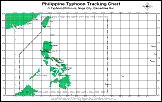
The threat of tropical cyclones nowadays is far reaching. Year after year, our civilization is affected by these howlers ranging from hurricanes, typhoons, cyclones and storms which belong to the family of tropical cyclones. This wrath of nature kills hundreds or even thousands of people, damaging many livelihood and properties. Now the question is: "How can we avoid them?" The answer to this is through awareness and understanding. Without this knowledge, the loss of lives will continue to be a risk factor in the evolution of civilization.
We welcome
you to our special section: A Guide on
How to Track Tropical Cyclones.
This simple tool will help you know and understand where a tropical
storm or a typhoon is going to strike.
Below is a step-by-step procedure on how to do it:
|
Step
1 |
Step
2 |
Step
3 |
|
|
|



